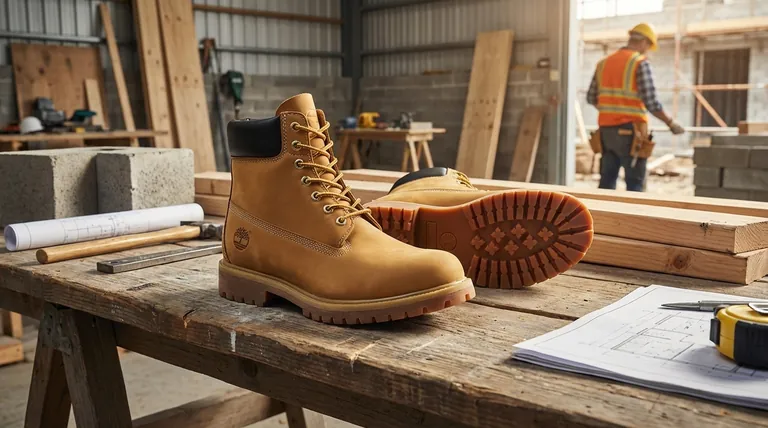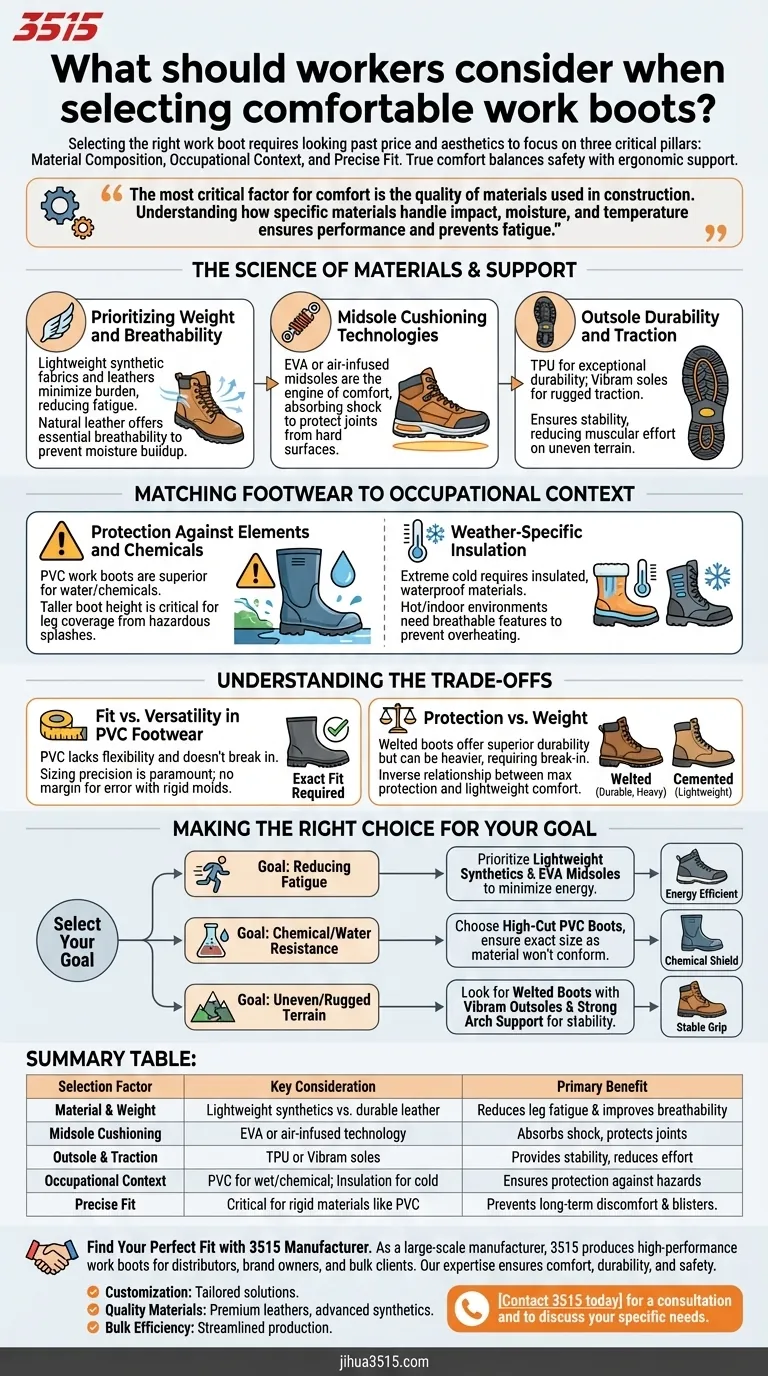Selecting the right work boot requires looking past price and aesthetics to focus on three critical pillars: material composition, occupational context, and precise fit. True comfort is achieved by balancing safety features with ergonomic support, such as cushioning and breathability, tailored to the specific demands of your workplace.
While many buyers prioritize style or low cost, the most critical factor for comfort is the quality of materials used in construction. Understanding how specific materials handle impact, moisture, and temperature is the only way to ensure performance and prevent long-term fatigue.

The Science of Materials and Support
Prioritizing Weight and Breathability
Modern work boots utilize lightweight synthetic fabrics and leathers to minimize the physical burden on your legs. Reducing the weight of the boot directly correlates to reduced fatigue over long shifts.
Furthermore, natural materials like leather offer essential breathability. This prevents moisture buildup inside the boot, which is a primary cause of discomfort and skin issues during extended wear.
Midsole Cushioning Technologies
The midsole is the engine of comfort. Look for boots featuring EVA (ethylene-vinyl acetate) or air-infused midsoles.
These materials absorb shock with every step, protecting your joints from impact on hard surfaces like concrete.
Outsole Durability and Traction
The outsole dictates how the boot interacts with the ground. TPU (thermoplastic polyurethane) offers exceptional durability, while Vibram soles are engineered for rugged traction.
Selecting the right outsole ensures stability, which reduces the muscular effort required to maintain balance on uneven or slippery terrain.
Matching Footwear to Occupational Context
Protection Against Elements and Chemicals
For environments involving water or chemicals, PVC work boots are often the superior choice.
In these scenarios, the height of the boot is a critical comfort factor. Taller boots provide essential coverage, protecting the lower legs from hazardous splashes that standard boots cannot deflect.
Weather-Specific Insulation
Your climate dictates your material needs. In extreme cold, insulated and waterproof materials are non-negotiable for maintaining circulation and comfort.
Conversely, in hot or indoor environments, these same features can cause overheating. You must assess the typical temperature range of your workspace before buying.
Understanding the Trade-offs
Fit vs. Versatility in PVC Footwear
PVC boots offer excellent protection, but they lack the flexibility of leather. Because they do not "break in" or stretch, sizing precision is paramount.
A PVC boot that is slightly too big or too small will remain uncomfortable forever. Unlike leather, there is no margin for error with rigid synthetic molds.
Protection vs. Weight
There is often an inverse relationship between maximum protection and lightweight comfort.
Welted work boots usually offer superior durability and reparability, often featuring removable insoles with high arch support. However, they may be heavier than cemented (glued) alternatives, requiring a short adjustment period.
Making the Right Choice for Your Goal
To select the best boot, you must align the features with your primary daily activity.
- If your primary focus is reducing fatigue during high-step counts: Prioritize lightweight synthetic materials and EVA midsoles to minimize energy expenditure.
- If your primary focus is chemical or water resistance: Choose high-cut PVC boots, ensuring the size is exact as the material will not conform to your foot.
- If your primary focus is uneven or rugged terrain: Look for Welted boots with Vibram outsoles and strong arch support to provide maximum stability.
Invest in the right materials for your specific environment, and your footwear becomes a tool that enhances, rather than hinders, your performance.
Summary Table:
| Selection Factor | Key Consideration | Primary Benefit |
|---|---|---|
| Material & Weight | Lightweight synthetics vs. durable leather | Reduces leg fatigue and improves breathability |
| Midsole Cushioning | EVA or air-infused technology | Absorbs shock from hard surfaces, protecting joints |
| Outsole & Traction | TPU or Vibram soles | Provides stability and reduces effort on uneven terrain |
| Occupational Context | PVC for wet/chemical environments; Insulation for cold | Ensures protection against specific workplace hazards |
| Precise Fit | Critical for rigid materials like PVC that don't stretch | Prevents long-term discomfort and blisters |
Find Your Perfect Fit with 3515 Manufacturer
As a large-scale manufacturer, 3515 produces a comprehensive range of high-performance work boots for distributors, brand owners, and bulk clients. Our expertise in material science and ergonomic design ensures every pair delivers the comfort, durability, and safety your workers need.
We offer:
- Customization: Tailored solutions for specific industries and hazards.
- Quality Materials: Boots crafted with premium leathers, advanced synthetics, and shock-absorbing midsoles.
- Bulk Efficiency: Streamlined production and sourcing for large-volume orders.
Let us help you equip your workforce with footwear that enhances performance and well-being.
Contact 3515 today for a consultation and to discuss your specific needs.
Visual Guide

Related Products
- Wholesale Durable 6-Inch Work Boots | Custom & Private Label Manufacturer
- Wholesale Durable Safety Boots | Custom Steel Toe & Puncture-Resistant Manufacturing
- Advanced KPU Athletic Safety Shoe with Steel Toe Cap Anti-Slip Rotary Lacing System
- Premium Wholesale Waterproof Safety Boots High Performance Protection for Industrial Markets
- Heavy Duty Nubuck Safety Boots Safety Shoes for Global Distribution
People Also Ask
- Why is the last important in work boot design? It's the Anatomical Blueprint for Comfort & Safety
- Why is manufacturer diversity and inclusion important in work boot design? For Superior Fit, Safety & Comfort
- What are some common styles of work boots? Find the Perfect Fit for Your Job
- Is it normal to wear shoes in the house? A Guide to Hygiene, Comfort & Culture
- What is the purpose of men's safety toe work boots? Complete Foot Protection for Hazardous Work



















